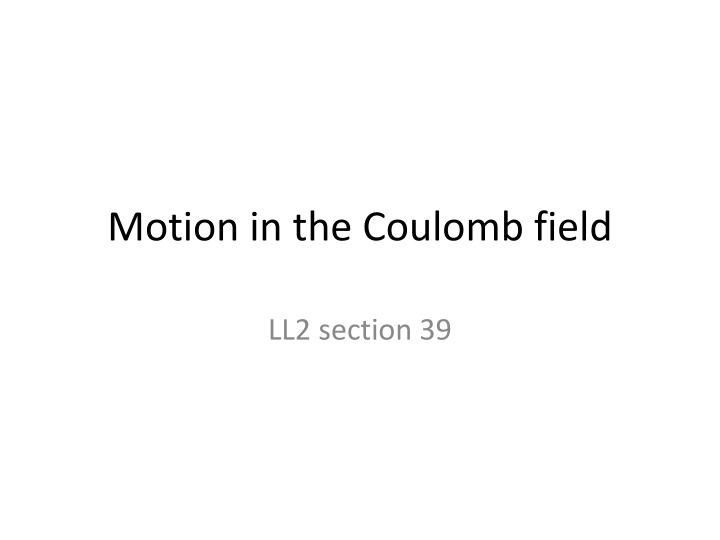
Motion in the Coulomb Field: Relativistic Perspectives
Explore the transition from non-relativistic to relativistic situations in the Coulomb field, examining conditions where a particle can or cannot fall to the center based on the relative mass, total energy, and angular momentum. Discover the implications of the Hamilton-Jacobi equation and the power of the HJ method in finding equations of motion for particles in electromagnetic fields.
Download Presentation

Please find below an Image/Link to download the presentation.
The content on the website is provided AS IS for your information and personal use only. It may not be sold, licensed, or shared on other websites without obtaining consent from the author. If you encounter any issues during the download, it is possible that the publisher has removed the file from their server.
You are allowed to download the files provided on this website for personal or commercial use, subject to the condition that they are used lawfully. All files are the property of their respective owners.
The content on the website is provided AS IS for your information and personal use only. It may not be sold, licensed, or shared on other websites without obtaining consent from the author.
E N D
Presentation Transcript
Motion in the Coulomb field LL2 section 39
The non-relativistic situation is Keplers problem. What is the relativistic situation? The larger mass is approximately fixed if m >> m The centrally symmetric field is
The total energy (relativistic kinetic and potential) is M is the constant angular momentum
Can the particle fall to the center? Not if e & e have the same sign (replusive Coulomb force). Not if e & e have opposite sign (attractive Coulomb force) AND Mc > | | (lots of angular momentum). In the second case, we always have | | and as r 0. But needs to be constant, So particle cannot fall into the center for this case.
If Mc < ||, then as r 0 and this one goes to - These go to + in such a way that can remain finite. The particle can fall to the center for the Coulomb field if the particle is relativistic.
In non-relativistic case, the total energy is So this inequality must hold. This term is positive definite. But this negative term wins as r 0. Thus, r cannot go to zero in non-relativistic case (for Coulomb field) unless M = 0.
Hamilton-Jacobi equation (a differential equation satisfied by the action.) replace
Separation of variables is possible for all cyclic variables, and even for some that are not-cyclic. Constant for cyclic coordinates The HJ method is the most powerful way to find equations of motion.
Coulomb field Polar coordinates r, in the plane of motion. 0
Trial solution Constant angular momentum Constant energy
The trajectory is determined by the condition See Mechanics volume 1, section 47 Constant, gives = ( , M, r) Three possibilities In relativistic mechanics the orbit is never closed. For < 0, < mc2, we get rosettes instead of ellipses. For > mc2, r Spirals, r as (if < 0, i.e. attractive Coulomb field)
